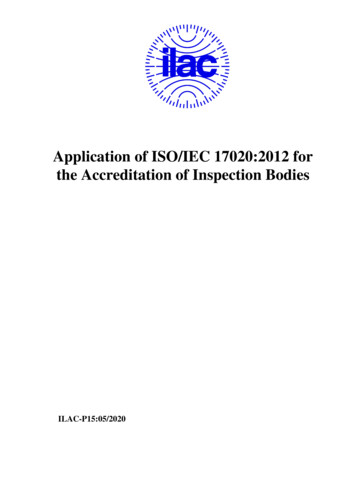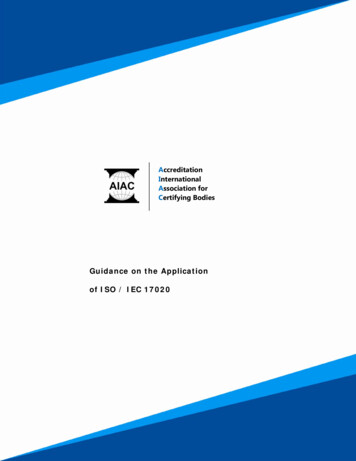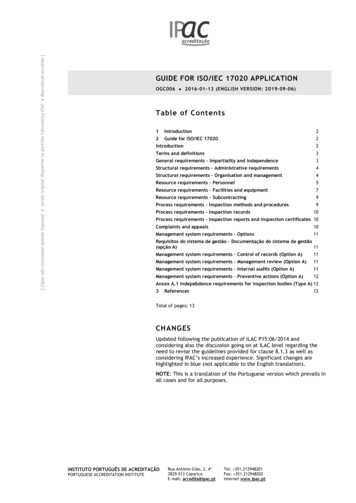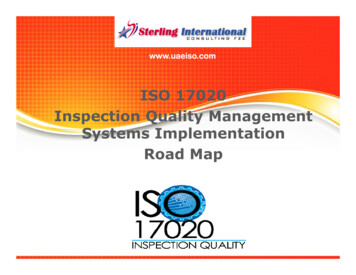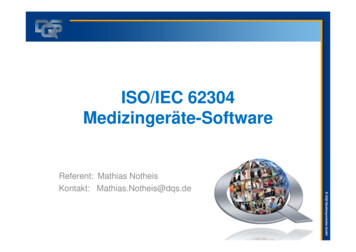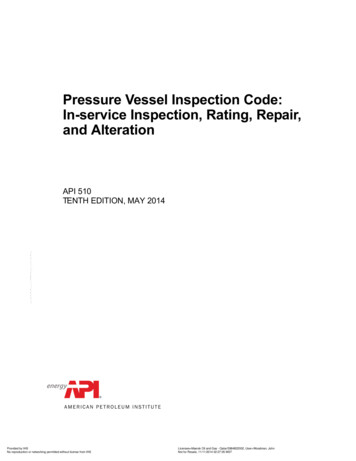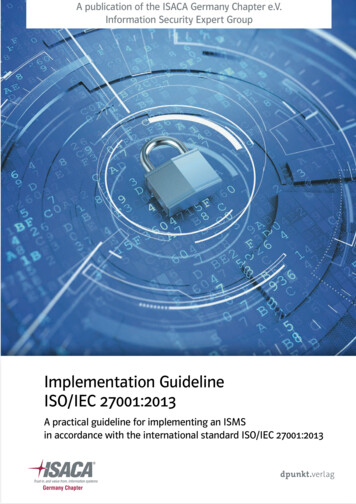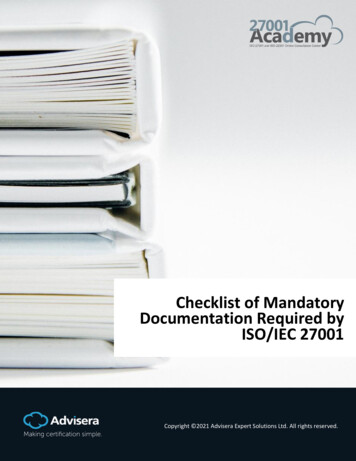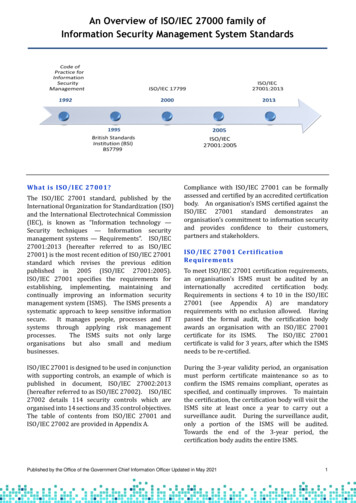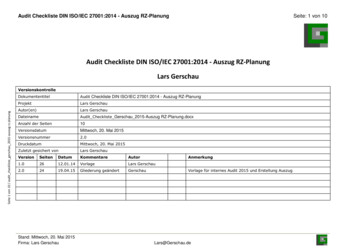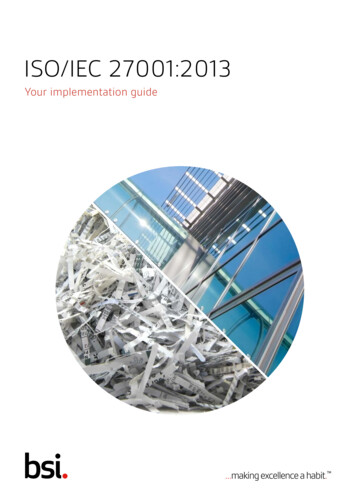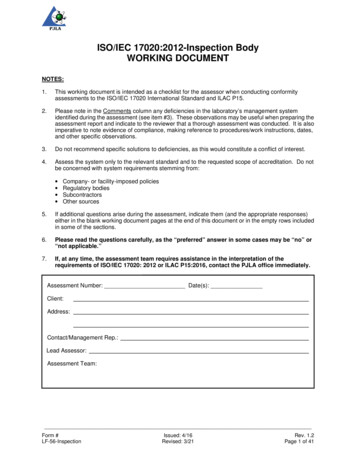
Transcription
ISO/IEC 17020:2012-Inspection BodyWORKING DOCUMENTNOTES:1.This working document is intended as a checklist for the assessor when conducting conformityassessments to the ISO/IEC 17020 International Standard and ILAC P15.2.Please note in the Comments column any deficiencies in the laboratory’s management systemidentified during the assessment (see item #3). These observations may be useful when preparing theassessment report and indicate to the reviewer that a thorough assessment was conducted. It is alsoimperative to note evidence of compliance, making reference to procedures/work instructions, dates,and other specific observations.3.Do not recommend specific solutions to deficiencies, as this would constitute a conflict of interest.4.Assess the system only to the relevant standard and to the requested scope of accreditation. Do notbe concerned with system requirements stemming from: Company- or facility-imposed policiesRegulatory bodiesSubcontractorsOther sources5.If additional questions arise during the assessment, indicate them (and the appropriate responses)either in the blank working document pages at the end of this document or in the empty rows includedin some of the sections.6.Please read the questions carefully, as the “preferred” answer in some cases may be “no” or“not applicable.”7.If, at any time, the assessment team requires assistance in the interpretation of therequirements of ISO/IEC 17020: 2012 or ILAC P15:2016, contact the PJLA office immediately.Assessment Number: Date(s):Client:Address:Contact/Management Rep.:Lead Assessor:Assessment Team:Form #LF-56-InspectionIssued: 4/16Revised: 3/21Rev. 1.2Page 1 of 41
ISOReq.CharacteristicYesNoComments regardingdeficiencies/effectiveness(if applicable)GENERAL REQUIREMENTS4.1 Impartiality and Independence4.1.1Are inspection activities carried outimpartially?4.1.2Does the inspection body bearresponsibility for the impartiality of itsinspection activities and ensure theabsence of commercial, financial, or otherpressures which can compromiseimpartiality?4.1.3Does the inspection body identify risks toits impartiality on an ongoing basis?This shall include those risks that arisefrom its activities, relationships, and therelationships of its personnel.ILACP154.1.3 n1“on an ongoing basis” means that theinspection body identifies a risk wheneverevents occur which might have a bearingon the impartiality of the inspection body.NoteNoteILACP154.1.3 n2The inspection body should describe anyof its relationships or its personnel’s thatcould affect its impartiality, to the extentrelevant, using organizational diagrams orother means.NoteNoteILACP154.1.3 n3Annex 1 gives an example of a possibleformat for impartiality risk analysis.NoteNote4.1.3NOTE : A relationship that threatens theimpartiality of the inspection body can bebased on ownership, governance,management, personnel, sharedresources, finances, contracts, marketing(including branding), and payment of asales commission or other inducement forthe referral of new clients, etc.NoteNote4.1.4Does the inspection body demonstratehow it eliminates or minimizes a risk toimpartiality if such is identified?ILACP154.1.4 n1Threats and inducements aimed atinspectors or other inspection bodypersonnel may represent serious risks toNoteNoteForm #LF-56-InspectionIssued: 4/16Revised: 3/21Rev. 1.2Page 2 of 41
ISOReq.CharacteristicYesNoComments regardingdeficiencies/effectiveness(if applicable)impartiality. Threats and inducementsmay originate from inside or outside theinspection body and may happen at anytime. The inspection body should recordperceived and explicit risks to impartialityof inspections. All personnel working onbehalf of the inspection body, should beaware of aware of the responsibility to actimpartially, be involved accordingly in theinspection body’s impartiality measuresand have appropriate access to providerecords as issues arise. The inspectionbody’s analysis of risks to impartialityshould include details of the inspectionbody’s responses to such risks.4.1.5Does the inspection body havecommitment from top management toimpartiality?ILACP154.1.5aNOTE: The inspection body should havea documented statement emphasizing itscommitment to impartiality in carrying outits inspection activities, managingconflicts of interest and ensuring theobjectivity of its inspection activities.Actions emanating from the topmanagement should not contradict thisstatement.NoteNoteILACP154.1.5bNOTE: One way for the top managementto emphasize its commitment toimpartiality is to make relevant statementsand policies publicly availableNoteNote4.1.6Is the inspection body independent to theextent required with regard to theconditions under which it performs itsservices?Depending on these conditions does itmeet the minimum requirements outlinedbelow (stipulated in Annex A)?4.1.6a) Does the inspection body meet the typeA requirements of Clause A.1 (appliesto third party inspection bodies only)?Form #LF-56-InspectionIssued: 4/16Revised: 3/21Rev. 1.2Page 3 of 41
ISOReq.CharacteristicYesNo4.1.6b) Does the inspection body meet thetype B requirements of Clause A.2(applies only to first partyinspections, second partyinspections, or both), which form aseparate and identifiable part of anorganization involved in the design,manufacture, supply, installation, useor maintenance of the items itinspects, and which suppliesinspection services only to its parentorganization (in-house inspectionbody)?4.1.6c ) Does the inspection body meet thetype C requirements of Clause A.3(applies only to first partyinspections, second partyinspections, or both, which form anidentifiable but not necessarily aseparate part of an organizationinvolved in the design, manufacture,supply, installation, use ormaintenance of the items it inspectsand which supplies inspectionservices to its parent organization or toother parties, or to both?ILACP154.1.6 n1An inspection body may have differenttypes of independence (Type A, B orC) for different inspection activitieslisted on the scope of accreditation.However, it is not possible for aninspection body to offer differentindependence types for the sameinspection activity.NoteNoteILACP154.1.6 n2Complying with the Type A independencerequirements A.1b and A.1.c is binary(yes or no) meaning that partlycomplying with Type A independencerequirements is not possible. This alsomeans that a risk analysis resulting incontrol measures to minimize theimpartiality risks of a situation wherethere is no compliance with theseType A requirements is not possible.Hence, only elimination of the situationthat is not compliant with these TypeA requirements is possible.NoteNoteComments regardingdeficiencies/effectiveness(if applicable)Form #LF-56-InspectionIssued: 4/16Revised: 3/21Rev. 1.2Page 4 of 41
ISOReq.CharacteristicYesNoNoteNoteNoteNoteComments regardingdeficiencies/effectiveness(if applicable)4.2 Confidentiality4.2.1Is the inspection body responsible for themanagement of all information obtainedorcreated during the performance ofinspection activities, through legallyenforceable commitments?Does the inspection body inform theclient, in advance of the information itintends to place in the public domain?Except for information that the clientmakes publicly available, or when agreedbetween the inspection body and theclient(e.g. for the purpose of responding tocomplaints), all other information isconsidered proprietary informationandshall be regarded as confidential.4.2.1NOTE: Legally enforceable commitmentscan be, for example, contractualagreements.4.2.2Is the client or individual concernednotified by the inspection body when theinspection body is required either by lawor authorized by contractual commitmentsto release confidential information?4.2.3Is information about the client, whenobtained from sources other than theclient, treated as confidential?5 Structural requirements5.1Administrative requirements5.1.1Is the inspection body a legal entity, or adefined part of a legal entity, such that itcan be held legally responsible for all itsinspection activities?5.1.1NOTE: A governmental inspection body isdeemed to be a legal entity on the basis ofits governmental status5.1.2Is the inspection body which is part of alegal entity involved in activities other thaninspection identifiable within that entity?Form #LF-56-InspectionIssued: 4/16Revised: 3/21Rev. 1.2Page 5 of 41
ISOReq.CharacteristicYesNoNoteNote5.1.3Does the inspection body havedocumentation describing the activities forwhich it is competent?ILACP155.1.3n1The inspection body should describe itsactivities by defining the general field andrange of inspection (e.g.categories/sub-categories of products,processes, services or installations) andthe stage of inspection, (see note toclause 1 of the standard) and, whereapplicable, the regulations, standards orspecifications containing the requirementsagainst which the inspection will beperformed. ILAC G28 gives guidance forthe Formulation of Scopes ofAccreditation for Inspection Bodies5.1.4Does the inspection body have adequateprovision (e.g. insurance or reserves) tocover liabilities arising from itsoperations?5.1.4NOTE: The liability can be assumed bythe State in accordance with nationallaws, or by the organization of which theinspection body forms a part.NoteNoteILACP155.1.4n1The level of provisions should becommensurate with the level and natureof liabilities that may arise from theinspection body’s activities.NoteNoteILACP155.1.4n2An assessment of ‘adequacy’ may bebased on evidence of agreement betweenthe parties to the contract andconsideration of any relevant statutoryrequirements or scheme rules. Theinspection body should be able to showwhat factors have been taken into accountwhen determining what constitutes“adequate provision”. It is not the role ofan accreditation body to approve theprovision held by an inspection body.NoteNote5.1.5Does the inspection body havedocumentation describing the contractualconditions under which it provides theinspection, except when it providesinspection services to the legal entity ofwhich it is a part?Comments regardingdeficiencies/effectiveness(if applicable)Form #LF-56-InspectionIssued: 4/16Revised: 3/21Rev. 1.2Page 6 of 41
ISOReq.Characteristic5.2Organization and management5.2.1Is the inspection body structured andmanaged in order to safeguardimpartiality?5.2.2Is the inspection body organized andmanaged in order to maintain thecapability to perform its inspectionactivities?5.2.2NOTE: Inspection schemes can requirethat the inspection body participates in theexchange of technical experience withother inspection bodies in order tomaintain this capability.ILACP155.2.2n1Is the size, structure, composition andmanagement of the inspection body,taken together, suitable for the competentperformance of the activities within thescope for which the inspection body isaccredited?ILACP155.2.2n2To maintain the capability to perform theinspection activities” does inspectionbody shall take steps to keep itappropriately informed about applicabletechnical, scheme and/or legislativedevelopments concerning its activities?ILACP155.2.2n3Does the inspection body maintain theircapability and competence to carry outinspection activities performedinfrequently (normally with intervals longerthan one year)?YesNoNoteNoteNoteNoteComments regardingdeficiencies/effectiveness(if applicable)An inspection body may demonstrate itscapability and competence for inspectionactivities performed infrequently through‘dummy inspections’ and/or throughinspection activities conducted on similarproducts.5.2.3Does the inspection body define anddocument the responsibilities andreporting structure of the organization?ILACP155.2.3n1Does the inspection body maintain anup-to-date organizational chart ordocuments clearly indicating the functionsand lines of authority for staff within theForm #LF-56-InspectionIssued: 4/16Revised: 3/21Rev. 1.2Page 7 of 41
ISOReq.CharacteristicYesNoNoteNoteNoteNoteComments regardingdeficiencies/effectiveness(if applicable)inspection body?The position of the technical manager(s)and the member of managementreferenced in clause 8.2.3 should beclearly shown in the chart or documents.5.2.4Does the inspection body define therelationship between other activities andinspection activities where the inspectionbody forms a part of a legal entityperforming other activities?ILACP155.2.4n1It may be relevant to provide informationconcerning personnel which carry outwork tasks for both the inspection bodyand for other units and departments inorder to take into account the involvementand the influence they may have over theinspection activities.5.2.5Does the inspection body have one ormore person(s) available as technicalmanager(s) who have overallresponsibility to ensure that the inspectionactivities are carried out in accordancewith this International Standard?Is (Are) the person(s) fulfilling this functiontechnically competent and experienced inthe operation of the inspection body? Arespecific responsibilities of each managerdefined and documented where theinspection body has more than onetechnical manager?5.2.5NOTE This person fulfilling this functiondoes not always have the title of technicalmanager.ILACP155.2.5n1In order to be considered as “available”, isthe person either employed or otherwisecontracted?ILACP155.2.5n2In order to ensure that the inspectionactivities are carried out in accordancewith ISO/IEC 17020, does the technicalmanager(s) and any deputy(ies), have thetechnical competence necessary tounderstand all significant issues involvedin the performance of inspectionactivities?Form #LF-56-InspectionIssued: 4/16Revised: 3/21Rev. 1.2Page 8 of 41
ISOReq.Characteristic5.2.6Does the inspection body have one ormore person(s) who will deputize in theabsence of any technical managerresponsible for ongoing inspectionactivities?ILACP155.2.6n1NOTE: In an organization where theabsence of a key person causes theces
ISO/IEC 17020:2012-Inspection Body WORKING DOCUMENT NOTES: 1. This working document is intended as a checklist for the assessor when conducting conformity assessments to the ISO/IEC 17020 International Standard and ILAC P15. 2. Please note in the Comments column any deficiencies in the laboratory’s management system identified during the assessment (see item #3). These observations
